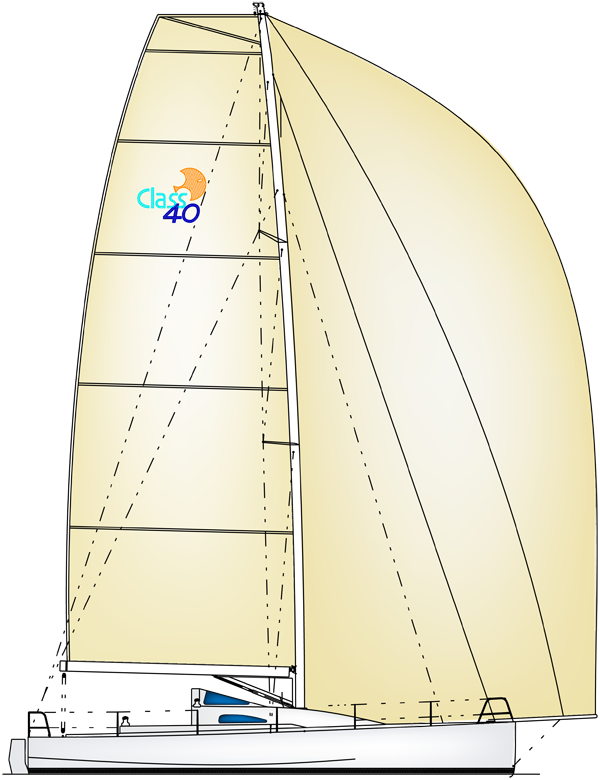Antrim Class 40
Racer
Now we are going to have some fun. I have two boats to review, both designed to conform to the Class 40 box rule. Remember, a "box rule" is a design rule that establishes maximum and minimum dimensions for the design. The boat has to fit in a "box" described by these limiting dimensional factors, including displacement. The boats are very similar as you would expect. The Class 40 rule was derived from the Open 40 rule and is an attempt at producing a more economical exotic racing boat. With the Open 40 class established, the newer Class 40 can use the work done in the Open 40 to get off to a quick, refined design start. Let's look at Jim Antrim's design for this class.
The Antrim 40 hull is designed to the minimum displacement for the rule-9,920 pounds-for a D/L of 73.68. Beam at 14 feet, 8 inches is taken to the class max for an L/B of 2.72. These are very beamy, light boats. Beam at the transom is 88.5 percent of beam max. The hull shape of the Antrim is all about chines. It is easy to see the chine developing just forward of amidships and extending to the transom. What is not clear in these drawings and renderings is that there is another chine forward. Imagine a nice, deep V-shaped forefoot extending aft and fairing to flat sections around the keel fin. Now take a knife and slice off the bottom of that forefoot starting just below the DWL at the stem and coming out right about at the keel's leading edge. So the entire bottom of this boat from keel fin to cutwater is flat. I called Jim and we talked about chines. I think I know why they are there but I wanted to be sure that I knew why he wanted chines.
The forward chine is all about designing a hull shape that will get up on a plane quickly The aft chine is all about stability and flat buttocks, again to help with planing speeds.
Chines will not work on just any boat. But, if you are designing a very high-powered boat where the boat will operate at super hull speeds most of the time, you can gain sailing length by eliminating aft overhang and adding a chine. The chine pushes hull volume outboard, resulting in an increase to stability and at the same time a flattening of the buttocks. You want flat buttocks for planing. Above the aft chine the hull is again just shaved off so that there is no hull just going along for the ride. The aft sections are slack through the bilge area then gently arced toward the centerline. It's a complex shape. Stability in this class is further enhanced by water ballast tanks. There are tanks to carry 1,650 pounds of water-340 gallons-on each side. That's like having eight 200-plus-pound friends sitting on the rail, day and night. The rule establishes maximum and minimum figures for stability.
The keel, drawing a class maximum of 9 feet, 11 inches, must be fixed. With a very broad stern on a beamy boat two rudders are a must. Note how far forward the max hull depth is on this design. Jim likes his LCB (Longitudinal Center of Buoyancy) forward, again to help planing. Unfortunately, this requires that the keel and ballast also be forward, so the designer runs into the old battle of keel placement versus rig placement. The SA/D for this big rig is 43.63, right at class max.
Columbia Yachts will build this speedster.
LOA 40'; LWL 39'2"; Beam 14'8"; Draft 9'11"; Displacement 9,920 lbs.; Ballast 4,960 lbs.; Water ballast 1,650 lbs.; Sail area 1,259 sq. ft.; SA/D 43.63; D/L 73.68; L/B 2.72; Auxiliary Yanmar YM30-SD20; Fuel 20 gals.; Water 13 gals.
Designer: Antrim Associates, 4018 Archery Way, El Sobrante, CA 94803, (510) 223-9680, www.antrimdesign.com.
Builder: Columbia Yachts,?308 E. Dyer Rd.,?Santa Ana, CA 92707, (714) 557-0712, www.columbiayachts.com.
OBE: $599,000
Our Best Estimate of the sailaway price

Comments